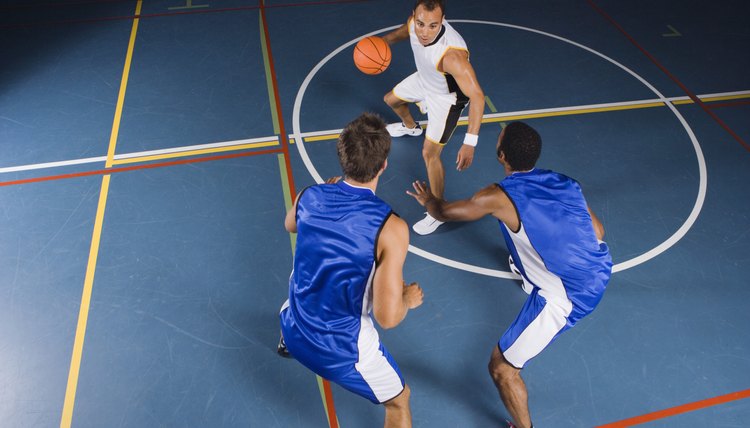Basketball Dribbling Rules

Among the most difficult rules of basketball for younger players to understand are those that involve dribbling the basketball. The concepts of violations such as double dribbles and palming the basketball are not easy to teach youngsters, and it is common to see even seasoned players commit these infractions. Dribbling rules cover situations such as when a player may dribble, when she may not and in what manner.
Dribbling and Traveling
One of the first things a coach attempts to convey to a new basketball player is not to run with the basketball without dribbling it. Dribbling and“traveling are two aspects of basketball that are joined at the hip via the rules. A player cannot take more than a step-and-a-half without dribbling the ball. If she does, then the referee will call traveling. Once a player stops dribbling the ball, the foot that lands on the court first is his pivot foot. He cannot pick this foot up again while in possession of the ball. If he does, then he, too, commits a traveling violation. For example, a player that ends his dribble and has his right foot become his pivot foot must either pass the basketball or shoot it at the goal. If he takes another step with the right foot before doing so, he commits a violation.
Double Dribble
A player can commit a double-dribble violation in one of two ways. The method which occurs most often is to voluntarily stop dribbling and then dribble again without passing or shooting the ball. The intent of the double-dribble rule is obvious to anyone even remotely familiar with the sport. If no such rule existed, a player could dribble the ball, pick it up and hold it, dribble again and repeat this action until she got close enough to the basket for an easy shot. Defenders would have little chance of stopping an offensive player without the double-dribble rule. Another way to commit a double dribble is to have both hands on the ball at the same time while in the act of dribbling it. The double-dribble violation gives the ball back to the opponent near the place where the double-dribble occurred.
Palming the Basketball
Palming the basketball, also known as “carrying” the ball, is a violation that occurs when a player gains an advantage on a defender by bringing his or her hand under the ball or onto its side while in the act of dribbling. Such actions give the player the ability to control the basketball without using a typical dribbling motion, and can help him to get the ball through traffic on the court or around a defender. A player may dribble the ball as high as she desires, as long as she keeps her dribbling hand on top of the ball. However, dribbling the ball too high allows a defender an excellent opportunity to snatch it away, as it stays in the air longer. The penalty for palming the basketball is loss of the ball to the opposing side. The referee will give the opponent the ball out of bounds near the spot of the infraction.
Writer Bio
John Lindell has written articles for "The Greyhound Review" and various other online publications. A Connecticut native, his work specializes in sports, fishing and nature. Lindell worked in greyhound racing for 25 years.
